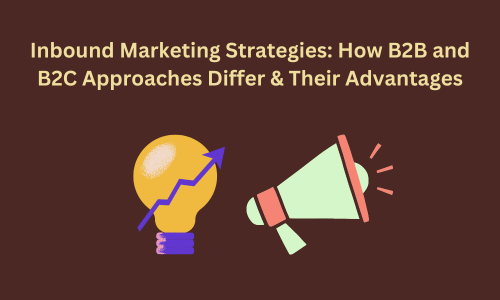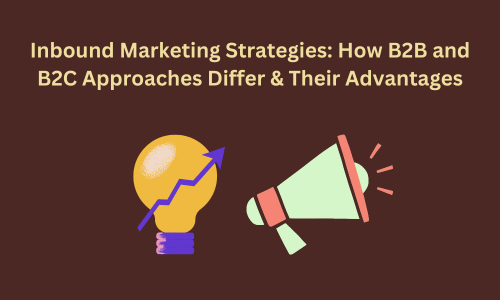


Inbound marketing has transformed the way businesses attract, engage, and convert customers. By focusing on creating valuable content and experiences tailored to the interests of their target audiences, inbound marketing shifts the dynamic from pushing products to pulling potential customers in. But while the core philosophy remains the same, the strategies employed differ significantly between B2B (business-to-business) and B2C (business-to-consumer) companies.
In this article, we'll explore the key differences between B2B and B2C inbound marketing strategies, highlighting the unique challenges, opportunities, and advantages each sector enjoys.
The first and most critical distinction between B2B and B2C marketing lies in the target audience.
B2B: B2B audiences are typically composed of decision-makers such as CEOs, procurement managers, and other high-level executives. These individuals are responsible for making long-term purchasing decisions that affect their companies’ bottom lines. Therefore, they tend to prioritize logic, ROI, and detailed information. B2B buyers are seeking solutions that will streamline operations, cut costs, or improve efficiencies, making the buying process more calculated and multi-faceted.
B2C: In contrast, B2C audiences are individual consumers with diverse needs, ranging from basic necessities to luxury products. Their buying behaviour is largely driven by emotion, convenience, and personal preferences. B2C consumers are more likely to make spontaneous or impulse purchases, driven by lifestyle aspirations, aesthetics, or the appeal of a quick solution.
Advantage: Understanding these differences allows companies to tailor content and messaging accordingly. B2B businesses can focus on delivering precise, ROI-driven content, while B2C businesses can leverage emotional connections to spark interest and loyalty.
Content lies at the heart of inbound marketing, but the approach to content creation varies between B2B and B2C businesses.
B2B: For B2B companies, content must be educational, authoritative, and data-driven. Buyers are looking for in-depth insights into how a product or service can solve complex business problems. Formats like whitepapers, case studies, eBooks, and webinars are commonly used to build trust and provide actionable insights. B2B messaging tends to be formal, emphasizing facts, figures, and long-term benefits.
B2C: B2C content is more likely to be entertaining, visually appealing, and easily digestible. Short-form content like videos, social media posts, blogs, and infographics works well to capture attention. B2C companies often use storytelling, humour, and emotional appeal to connect with consumers on a personal level. Messaging is typically casual and focused on the benefits that directly impact the consumer’s lifestyle or convenience.
Advantage: B2B businesses can establish themselves as industry thought leaders through valuable and insightful content, while B2C companies can create memorable and engaging content that fosters brand loyalty and resonates with consumers emotionally.
Generating leads and converting them into customers is a key objective of inbound marketing. However, the approach to lead generation and conversion varies greatly between B2B and B2C.
B2B: In B2B marketing, lead generation tends to focus on nurturing relationships over an extended period. Sales cycles are longer and often involve multiple stakeholders, requiring a more personalized and thoughtful approach. Tools like gated content, email drip campaigns, and account-based marketing (ABM) are critical. B2B marketers often use platforms like LinkedIn to reach decision-makers and influencers within target organizations.
B2C: B2C lead generation is more geared toward quick conversions. Since buying decisions are more impulsive, B2C marketing often leverages retargeting ads, influencer partnerships, and social media engagement to drive immediate action. Platforms like Instagram, Facebook, and TikTok are essential for building awareness and encouraging fast purchases.
Advantage: B2B companies benefit from cultivating long-term relationships with higher customer lifetime value, while B2C businesses can drive higher transaction volumes and benefit from faster sales cycles.
Search engine optimization (SEO) is a powerful tool for inbound marketing, but the SEO strategies for B2B and B2C businesses differ significantly.
B2B: B2B SEO strategies often focus on long-tail keywords that are industry-specific and designed to target a niche audience. B2B marketers use technical language and in-depth content to establish authority in their sector. The goal is to attract highly qualified leads who are actively searching for complex solutions.
B2C: On the other hand, B2C SEO strategies typically target high-volume, general keywords that align with consumer search behaviour. The focus is on capturing a broader audience and ranking for terms that reflect consumer interests, trends, and immediate needs.
Advantage: B2B businesses can attract highly targeted leads through niche, industry-specific content, while B2C companies benefit from driving high traffic volumes and visibility.
The customer journey varies significantly between B2B and B2C.
B2B: The B2B customer journey is usually more complex and involves multiple stages. The process is longer, with stakeholders often conducting extensive research, engaging with sales teams, and seeking approval from various decision-makers. This complexity means that B2B companies must focus on lead nurturing and providing high-value content at every stage of the funnel.
B2C: In contrast, the B2C customer journey tends to be simpler and shorter. Consumers may make purchasing decisions after minimal research, particularly if the product appeals to their emotions or solves a short-term need. B2C marketers aim to reduce friction in the purchasing process and often offer discounts, promotions, and streamlined checkout experiences.
Advantage: B2B businesses have the opportunity to build stronger, long-term partnerships, while B2C companies can take advantage of quicker decision-making and immediate feedback from their audience.
Email marketing and automation play crucial roles in both B2B and B2C strategies, but they serve different purposes.
B2B: B2B email marketing is typically formal and designed to nurture leads through informative content. Segmentation is key, with emails targeted based on factors like industry, company size, or job title. Automation is crucial in B2B for maintaining ongoing communication, especially in longer sales cycles.
B2C: B2C email marketing is more promotional and focuses on personalized product recommendations, exclusive offers, and loyalty programs. B2C email campaigns often include cart abandonment reminders and follow-up emails to increase conversion rates.
Advantage: B2B businesses can leverage email automation to foster deep relationships with prospects, while B2C companies can drive repeat purchases and build brand loyalty through engaging, personalized emails.
Measuring the success of inbound marketing campaigns also differs between B2B and B2C.
B2B: B2B marketers focus on metrics like lead quality, sales cycle length, customer acquisition cost (CAC), and customer lifetime value (CLTV). The emphasis is on securing a smaller number of high-value deals, which often require multiple touchpoints.
B2C: B2C marketers prioritize metrics such as website traffic, social media engagement, conversion rates, and average order value (AOV). The goal is to drive large volumes of transactions and optimize for maximum revenue per transaction.
Advantage: B2B businesses benefit from high-value, long-term contracts, while B2C companies can track and optimize real-time results for faster wins.
Inbound marketing is a versatile strategy that works for both B2B and B2C businesses, but success lies in understanding the distinct needs of your audience. For B2B companies, the focus on building trust, nurturing long-term relationships, and providing in-depth content can yield high-value contracts and loyal partnerships. For B2C companies, the ability to create emotional connections, drive quick conversions, and leverage mass appeal can result in rapid growth and brand loyalty.
By aligning your inbound marketing strategies with the specific demands of your market—whether B2B or B2C—you can maximize engagement, conversions, and long-term success.
Disclaimer: This article is provided for informational purposes only. It is not offered or intended to be used as legal, tax, investment, financial, or other advice.
